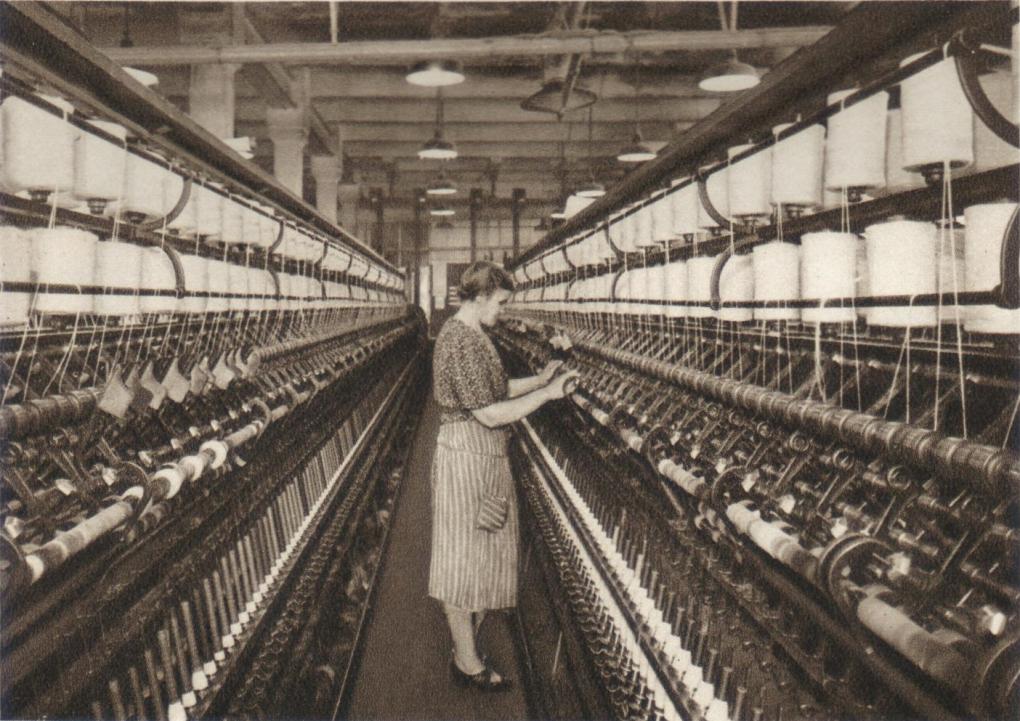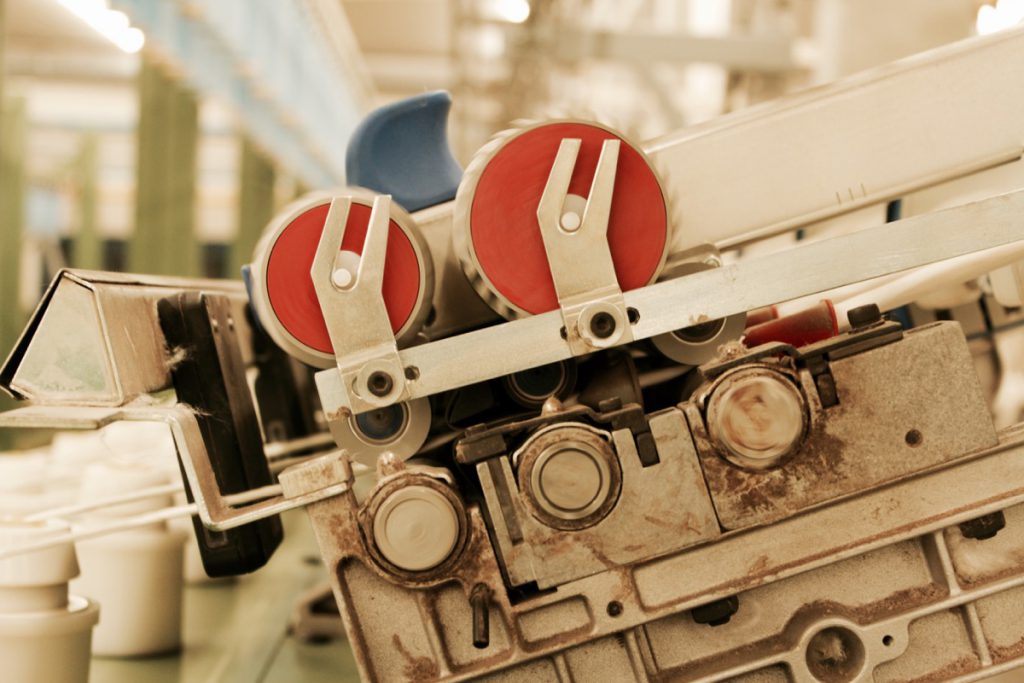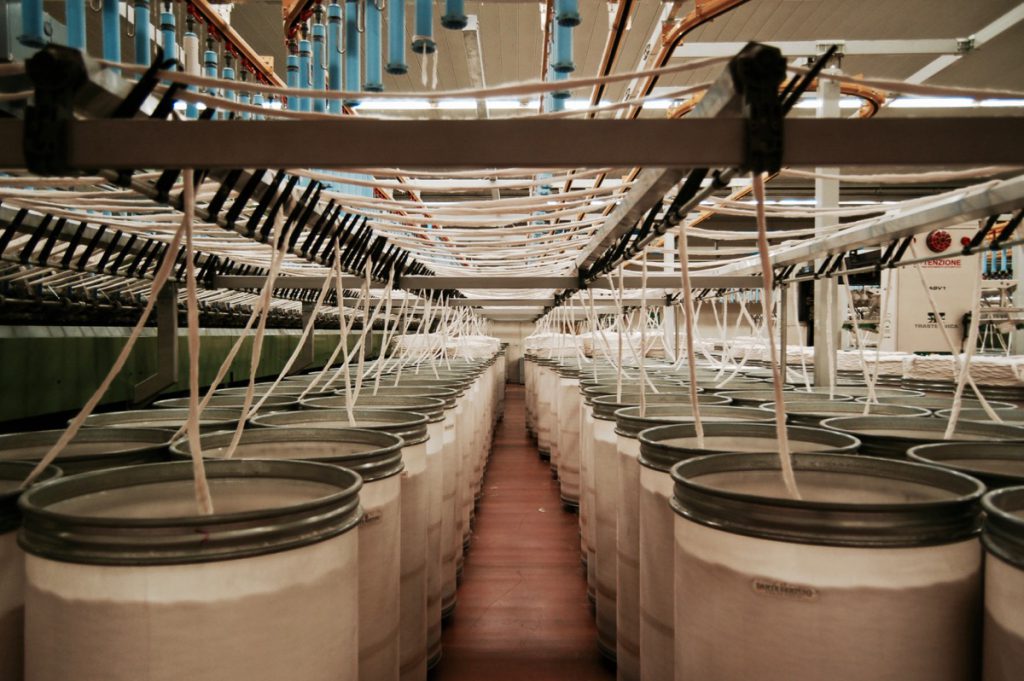Spinning is the process of turning fibres into yarn. There are two methods to achieve this: ring spinning and open-end spinning.
Ring spinning was the method of choice for denim producers until the 1970s when the industry turned to open-end spinning, also known as ‘rotor spinning.’
But with the advancements in stretch denim and the growing demand for “authentic” denim, ring spinning has regained the position as the industry’s go-to spinning method.

While the two methods differ, they both involve two stages: preparation and the actual spinning.
In the preparation stage, the fibres are parallelised and elongated. The goal is to take full advantage of the length of the fibres to get durable and resistant yarn.
Once the fibres have been parallelised and elongated, torsion enters the picture. This is where the actual spinning happens as the fibres are twisted around each other. And this is where the two methods differ.
Below, we explain the spinning process in more detail.
The history of spinning
Back in the day, before the Industrial Revolution, spinning was a manual operation. These days, there are two predominant spinning methods. And each of them has its pros and cons.
The old-timer of spinning is ‘ring spinning.’ It’s been around since in 1828 when the first ring spinning machine was invented in the US. Of course, the technology has been considerably modified since then, but the basic concept remains the same.

Ring spinning was the method of choice for denim producers until the 1970s. That’s when the industry turned to ‘open-end spinning,’ also known as ‘rotor spinning,’ which was invented in 1963 in Czechoslovakia.
In recent years—fuelled by the advancement of denim made from stretch yarn (which can only be made with ring spinning) and the growing demand for “authentic” denim—ring spinning has regained the position as the industry’s go-to spinning method.
The spinning process explained
As mentioned above, there are two stages in the spinning process: preparation and the actual spinning.
Preparing the cotton fibres for spinning
The first stage is preparing the fibres by parallelising and elongating them. The goal is to take full advantage of the length of the fibres to get durable and resistant yarn.
It starts with the machine known as the ‘bale plucker,’ which picks the cotton fibres off a row of cotton bales. The fibres are then mixed and cleaned to remove leftover seeds from the ginning process.

Next, the fibres fall into two differentially rotating cylinders full of needles in the ‘carding machine.’ This starts the parallelising process. Once carded, the fluffy thick rope of fibres is referred to as the ‘sliver.’

After carding, six slivers are merged and elongated as three cylinders move at successively higher speeds on the ‘drawing frame.’ This process may be repeated twice, depending on the equipment and layout of the factory, which means the final sliver can be comprised of no less than 36 of the original slivers.
Applying torsion (in other words, the actual spinning)
Once the fibres have been parallelised and elongated, torsion enters the picture.
This is where the actual spinning happens as the fibres are twisted around each other. It’s here the two spinning methods differ.
Ring spinning
In ring spinning, the sliver of yarn is fed into what’s called the ‘roving frames’ where torsion is applied for the first time in the process.

The sliver then goes into the ‘drafting system,’ which twists it into a thin ribbon.


Next, it’s twisted even more by the ‘rotating spindle.’ Enclosing the spindle is a ‘ring rail’ that gives the method its name.
On the ring rail, a small clip called ‘the traveller’ is dragged around with the rotating spindle to twist the yarn even more.
As the ring moves up and down, the yarn is wound onto a bobbin, technically known as the ‘ring cop.’
Stretch yarn
To make stretch denim, you need to add a synthetic elastomer to the yarn in the spinning process, and you get the best result with ring spinning.
That’s because the stretch is spun directly into the core of the yarn with the cotton wrapped around the elastomer. This way, you maintain the soft touch and fading capabilities of cotton, while adding stretchability.
The advantage stretch denim is that it makes the jeans a lot more comfortable. But there are downsides too.
Open-end spinning
In open-end spinning, you only need to do the drawing process once. Compared to ring spinning, you don’t have the roving frames, the drafting system or the ring and traveller enclosing the ring cop to apply torsion.
Instead, the sliver is fed directly into the ‘spinner’ by a stream of air, delivering it to a ‘rotary beater’ that separates the fibres into a thin stream. Air then carries the fibres into the V-shaped groove with a rotor at the end. As the rotor turns, the fibres are twisted.
One thing both ring-spun and open-end yarn have in common is that their three characteristics are carefully controlled to design the yarn to be exactly like the yarn designer wants it.
Ring spinning vs. open-end spinning
By now you should have a pretty good idea of what spinning is and how it’s done. So let’s compare the pros and cons of the two methods.
Pros of ring spinning
- Ring spinning produces a soft and durable yarn with the unique and uneven texture that has come to define authentic denim. It’s the roving frame and drafting system that give the yarn its unique and irregular surface with natural slubs.
- Enables multi-core yarns where polyesters or other materials provide strength and/or elasticity to the yarn without affecting how it looks and feels on the outside.
Cons of ring spinning
- Ring spinning requires more production steps compared to open-end spinning, which makes it more expensive.
Pros of open-end spinning
- Open-end spinning is up to ten times faster than ring spinning. That’s mainly because it spins a lot faster. But it’s also because the process eliminates one of the draw frames and the roving frame. This obviously makes open-end spinning cheaper than ring spinning.
Cons of open-end spinning
- Open-end-spun yarn lacks the cherished features of ring-spun yarn. The yarn is so refined that it makes the denim even and flat. That’s because the thickness of the yarn is consistent without natural slubs.
- As the fibres are not spun in a parallel direction, open-end yarn is fuzzier compared to ring-spun yarn. This means it absorbs more indigo, which makes it harder to get high-contrast fades.
- Furthermore, open-end spinning cannot produce stretch yarn.
The characteristics of spun yarn
Nothing is left to chance in spinning. It’s not only the fit and details of your jeans that are designed, the yarn is too. Yarn designers work with three characteristics to control the look, feel and fade of the fabric:
- the thickness of the yarn
- the texture, and
- how twisted it is.
Respectively, those characteristics are technically known as: ‘yarn count,’ ‘slubs’ and ‘torsion.’
Yarn count (thickness of yarn)
The thickness of yarn is measured by mass per unit length.
The spinning industry usually uses the English cotton count, known as ‘Ne.’ The yarn used for denim usually has a yarn count between Ne 4 and Ne 20. The higher the number, the finer the yarn—the finest yarns measure around Ne 200.

Not many brands and retailers advertise the yarn count; often because they either don’t know or because it’s considered irrelevant information for their target audience.
But, when you see denim listed as 7×7, 6×6, or something similar, that’s the yarn count for the warp and the weft yarn, respectively.
Slubs (texture of yarn)
This Encyclopedia entry is a must-know term. Learn more in our Denim vocabulary.
Slubs is a measurement for the regularity of the yarn, which tells you about its texture. Back in the day, before the modern denimhead idolised slubs, they were considered imperfections.
These lumps or nebs in the cotton yarn are desired imperfections that give the denim an uneven appearance.
Once the yarn has been dyed, woven, and after some wear and/or wash, the slubs present themselves as vertical streaks that are brighter than the rest of the fabric.
If denim is slubby, it has a lot of slubs and thus a lot of character. Without slubs, denim is flat, and it fades more evenly.

In ring spinning, the uneven speed of the ring frame—in other words, the roving frame and the drafting system—creates the slubs. The slubs can be as short as the length of the single fibre, around 30 mm.
When the denim industry turned to open-end spinning in the 1970s, no one mourned the loss of the natural irregularities of ring-spun yarn. But when vintage denim (and new denim that was designed to look old) became big business in the 1980s, makers started incorporated methods that create slubs in open-end yarns.
It’s done electronically with small changes in the speed of the rotor and the velocity of the air stream. The shortest slubs in open-end spinning are the circumference of the rotor, which is roughly 90 mm.
Torsion (twist of yarn)
Torsion measures the twist of the yarn. This tells you how the dyestuff permeates it. And that’s a crucial piece of information. The higher the torsion, the less indigo it absorbs.
Denim made from yarn with a high yarn twist fades faster. Another bonus of high yarn twist is that it makes the denim stronger.
In open-end spinning, the fibres are not spun in a parallel direction. This means they’re less twisted. The yarn is fuzzier and more open compared to ring-spun yarn, which makes the dye penetrate deeper into its core.
That’s why it’s harder to get high-contrast fades from open-end denim.

